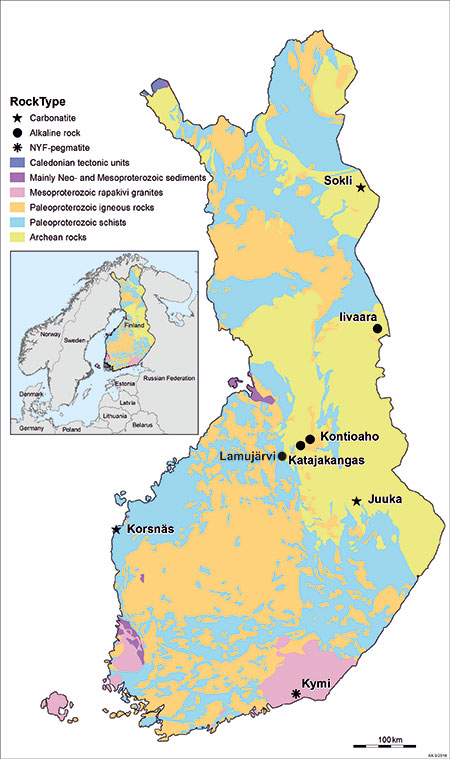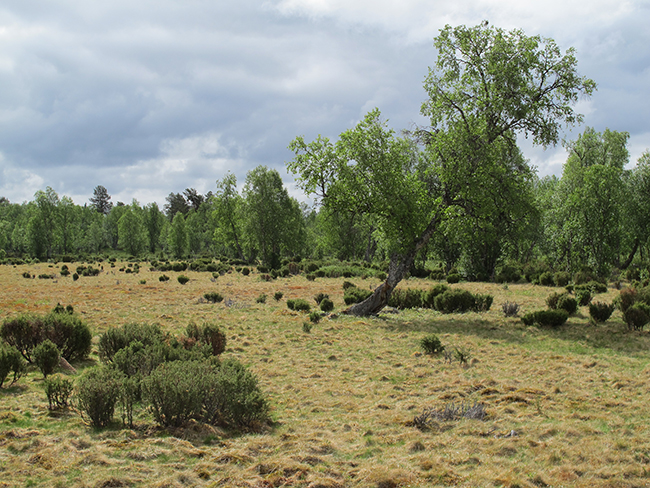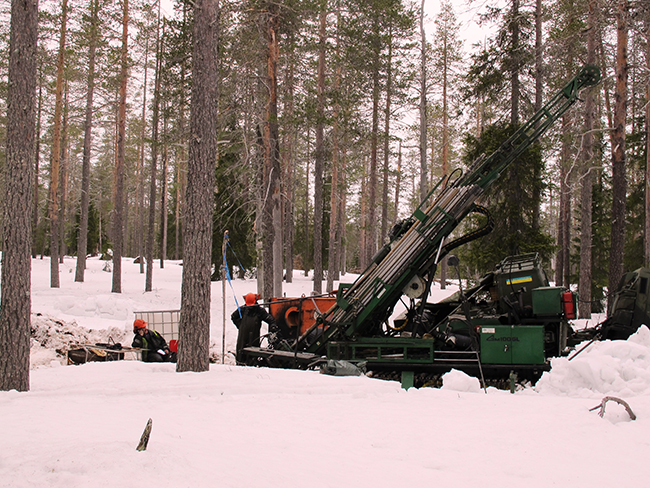REE mineralisation in Finland
Finland is situated in the central part of the Fennoscandian shield, which is the largest outcropping Precambrian domain in Europe, and has high potential for exploration of REE and other metals. The known examples of REE mineralisation in Finland occur in carbonatitic and alkaline intrusives, granites, hydrothermal rocks and kaolinitic saprolites. There are currently no economic REE deposits in Finland, although REE were extracted between 1963 and 1972 from apatite concentrate mined as a by-product in the Korsnäs lead (Pb)-REE mine in western Finland. In the future, REE could potentially be extracted as a by-product of mining for commodities such as phosphorus (P) and gold (Au). Currently the most promising REE deposit is associated with the Sokli carbonatite complex in north eastern Finland.
REE in carbonatitic intrusives
The Sokli carbonatite (approximately 360 – 380 Ma) in north eastern Finland, a part of the Devonian Kola alkaline province, hosts an unexploited deeply weathered phosphate deposit enriched in niobium (Nb), tantalum (Ta), zirconium (Zr), REE and uranium (U). The carbonatite intrusion consists of a magmatic phoscorite-carbonatite core, surrounded by metacarbonatite and a wide fenite aureole, altogether about 9 km in diameter. Late-stage carbonatite veins in the magmatic core and in the fenite zone have high potential for REE mineralisation (Vartiainen, 1980; Al Ani and Sarapää, 2013). Chemical analyses from drill cores show that the carbonatite veins are enriched in phosphorus pentoxide (P2O5) (19.9 weight per cent), strontium (Sr) (1.9 weight per cent), barium (Ba) (6.8 weight per cent), Zn (0.3 weight per cent) and also have a high total REE content of 0.5 – 1.8 weight per cent (Sarapää et al., 2013). The mineral assemblage includes REE-bearing ancylite-(Ce) and bastnäsite-(Ce), Sr-apatite, monazite, strontianite, baryte and brabantite, rich in LREE, P, fluorine (F), Sr and Ba. During late-stage processes, apatite and carbonate minerals were replaced by various assemblages of REE-Sr-Ba minerals.
The Korsnäs Pb-REE-bearing carbonatite dyke intrudes Palaeoproterozoic mica-gneisses of the South Pohjanmaa schist belt. The Outokumpu Oy mining company operated the Korsnäs mine from 1961 to 1972 and produced 45 000 tons Pb and 36 000 tons of lanthanide concentrate. The grade of the ore was 3.57 per cent Pb and 0.91 per cent total rare earth oxides (RE2O3). The major ore minerals were galena, apatite, monazite and allanite. The deposit consists of mineralised zones in pegmatite and carbonatite or calcareous scapolite-diopside-barite-bearing skarn rock. The wall rock of the dyke has been kaolinised in the strongly sheared ore zone. Apatite and monazite are heterogeneously distributed in the ore but follow galena.
A swarm of REE enriched carbonatite dykes and associated alkaline veins is found within an extensive area, covering over 100 sq.km, centered around Panjavaara in Juuka, Eastern Finland. The dikes and veins are highly enriched in REE, with concentrations reaching 5-10 %, and even the smallest veinlets typically showing 1-2 % total REE. The studied rocks display elevated LREE to HREE ratios, with bastnäsite, ancylite, and monazite as the most important REE carriers.
REE in alkaline intrusives
Iivaara is the type locality of ijolite, which is a common rock type in carbonatite-bearing alkaline complexes. The phosphor potential of the Iivaara intrusion is very high, but the REE potential is still under study. The Iivaara intrusion shows many similarities with the Lovozero alkaline massif in Russia, which is mined on a small scale for REE. Geophysical interpretation has revealed ring structures around the Iivaara intrusion, which could be potential REE targets.
The Katajakangas Nb-REE mineralisation is located within Precambrian alkaline gneissic granite in the Otanmäki area, central Finland. The nearby Kontiaho mineralisation is similar, but a resource estimate is only available for the Katajakangas occurrence. The Katajakangas mineralisation forms narrow lenses or layers, up to a few metres wide, within sheared quartz-feldspar gneiss with riebeckite and alkali pyroxene. The main ore minerals are zircon, bastnäsite, columbite and thorite. The narrow mineralised zone in the Katajakangas alkaline gneiss contains high concentrations of Nb, Zr, yttrium (Y), thorium (Th) and REE, with an estimated Nb-YREE resource of 0.46 million tons at 2.4 per cent RE2O3, 0.31 per cent Y2O3 and 0.76 per cent NbO (Sarapaa et al., 2013). The alkaline gneiss contains 0.7 – 1.5 per cent Zr and 0.1 – 0.2 per cent Th.
The Lamujärvi syenites in central Finland display strong enrichment in Zr (1587 parts per million (ppm)), Nb (up to 685 ppm), Ta (up to 82 ppm) and REE (up to 5350 ppm), but the grades and volumes of these rocks appear too small to be currently of economic potential. The major REE-bearing minerals in the enriched rocks are allanite and monazite.
REE in granitic pegmatites and granites
The late-orogenic peraluminous Kovela monazite-granite shows up as a strong positive aeroradiometric gamma radiation anomaly in the Svecofennian Uusimaa Belt. Monazite is the dominant REE-mineral; accessory minerals include zircon, xenotime, and thorite. The REE contents in drill core sections vary from 0.6 per cent to 4.3 per cent. The Th content varies between 1110 and 10 100 ppm and the U content between three and 320 ppm. Miarolitic pegmatites with topaz and fluorite are typical in the Wiborg rapakivi batholith, south eastern Finland. The largest and mineralogically most interesting REE pegmatites surround the Kymi topaz granite stock and contain REE minerals (monazite, xenotime), Nb-Ta minerals, beryl, phenacite, bertrandite and tourmaline.
REE in kaolinitic saprolites
The Virtasalmi kaolin deposits in south east Finland have thicknesses of 30 – 40 m, locally up to 100 m. The kaolin contains 40 to 75 weight per cent kaolinite, 20 – 30 per cent quartz and some potassium (K)-feldspar and muscovite. The total REE content of kaolin in the basal part of the weathering profile reaches a maximum 0.1 – 0.2 per cent REE.
The 200 km long Tana Belt on the southern side of the Lapland Granulite Belt includes HREE and LREE anomalies in regional till geochemistry and kaolinitic saprolite. The REE content in Mäkärä Au-bearing saprolite is 0.05 per cent, locally up to 0.4 per cent REE in saprolite. Typical REE-rich minerals are monazite, rhabdophane and xenotime.
Key references
Al Ani, T and Sarapää, O. 2013. Geochemistry and mineral phases of REE in Jammi carbonatite veins and fenites, southern end of the Sokli complex, NE Finland. Geochemistry: Exploration, Environment, Analysis, v. 13:217–224.
Sarapää, O and Sarala, P. 2013. Rare earth element and gold exploration in glaciated terrain — example from the Mäkärä area, northern Finland. Geochemistry: Exploration, Environment, Analysis, v. 13:131–143.
Sarapää, O, Al Ani, T, Lahti, S I, Lauri, L S, Sarala, P, and Torppa, A. 2013. Rare earth exploration potential in Finland. Journal of Geochemical Exploration, Volume 133, 25–41.
Vartiainen, H. 1980. The petrography, mineralogy and petrochemistry of the Sokli carbonatite massif, northern Finland. Geological Survey of Finland, Bulletin 313, 126 p.



